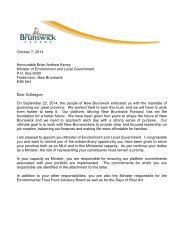cbd-ts-67-en
cbd-ts-67-en
cbd-ts-67-en
- No tags were found...
You also want an ePaper? Increase the reach of your titles
YUMPU automatically turns print PDFs into web optimized ePapers that Google loves.
Section 1: Impac<strong>ts</strong> of marine debris on biodiversity<br />
It is clear from these repor<strong>ts</strong> that numerous individuals and species have died or become harmed as a consequ<strong>en</strong>ce<br />
of <strong>en</strong>tanglem<strong>en</strong>t and ingestion <strong>en</strong>counters with marine debris. It is, however, likely that a much larger number<br />
of individuals are compromised by sub-lethal effec<strong>ts</strong> that have not be<strong>en</strong> fully reported. For example, debris on<br />
beaches has be<strong>en</strong> shown to affect behaviour of intertidal organisms such as the gastropod Nassarius pullus (Aloy<br />
et al., 2011) and adversely affect the ability of turtle hatchlings to reach the sea (Ozdilek et al., 2006).<br />
It seems inevitable that <strong>en</strong>tanglem<strong>en</strong>t and ingestion of marine debris will alter the biological and ecological<br />
performance of individuals. A number of possibilities have be<strong>en</strong> suggested, including compromising an<br />
individual’s ability to capture food, digest food, s<strong>en</strong>se hunger, escape from predators, and reproduce—as well<br />
as decreasing body condition and compromising locomotion, including migration (e.g. Ryan, 1988; Spear et al.,<br />
1995; Laist, 1987; Laist, 1997; Derraik, 2002; Gregory, 2009; Aloy et al., 2011). It has also be<strong>en</strong> widely suggested<br />
that ingestion of debris, and in particular microplastic debris, might provide a pathway facilitating the transport<br />
of harmful chemicals to organisms (Oehlmann et al., 2009; Teut<strong>en</strong> et al., 2009). (see also Section 1.4.3 below).<br />
The consequ<strong>en</strong>ces of ingestion are not fully understood. There are concerns that microplastics may cause physical<br />
disruption for example, by interfering with feeding and digestion. Little is known about such physical effec<strong>ts</strong>,<br />
although there is evid<strong>en</strong>ce that particles can be retained for several weeks after ingestion (Browne et al., 2008).<br />
1.4.3 Microplastics<br />
Marine debris, and in particular plastic debris, is fragm<strong>en</strong>ting in the <strong>en</strong>vironm<strong>en</strong>t. Much of the debris collected<br />
during survey trawls (Law et al., 2010; Thompson et al., 2004) and on shorelines (Browne et al., 2010) consis<strong>ts</strong><br />
of tiny particles of microplastic (Figure 8). This material has be<strong>en</strong> defined as pieces or fragm<strong>en</strong><strong>ts</strong> less than 5<br />
mm in diameter (Arthur et al., 2009; Barnes et al., 2009). The abundance of microplastics is increasing in the<br />
oceans (Thompson et al., 2009, Goldstein et al., 2012), and data pres<strong>en</strong>ted here indicate that around 10 % of all<br />
reported <strong>en</strong>counters are with microplastics.<br />
FIGURE 8: A) Marine debris on a strandline where it fragm<strong>en</strong><strong>ts</strong> into smaller pieces. B) A fragm<strong>en</strong>t of microplastics next to a grain of<br />
sand found on a beach in Cornwall, UK. C) Scanning electron microscope image of microplastic fragm<strong>en</strong><strong>ts</strong>. Source: R.C. Thompson.<br />
19



